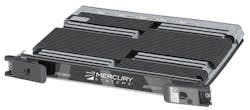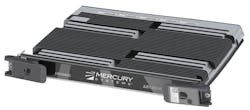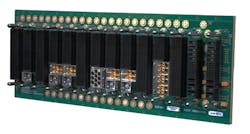Data and networking push advances in embedded computing
An ever-increasing demand for intelligent, actionable data, combined with a boom in connected devices, is shaping how developers design the next generation of embedded computing systems.
By Michael Harris
As the aerospace and defense systems employed across the land, sea and air become increasingly more sophisticated, it should come as no surprise that demands for data are growing at an exponential rate.
This data must be secure, reliable, and perhaps above all else, actionable — and as a result, technology developers must balance customer needs constantly with infrastructure constraints, safety certifiability and, increasingly, adherence to new standards set by the industry itself.
The cockpit of tomorrow
Though the aircraft cockpits in many aircraft historically have relied on a hodgepodge of mechanical gauges to display information, flight decks quickly are transforming into sleek workstations filled with digital flat screens.
This “glass cockpit” approach enables operators to consolidate systems and access robust information in near real-time conditions, though it requires ample computing and data transfer capabilities.
“Whether it’s a cockpit gauge, radar display, map, or some other thing that stood on its own and was its own self-contained system, all of those things are now being pulled over to one single pane of glass in the front of the cockpit,” says Andrew McCoubrey, senior product manager for networking at Curtis-Wright Defense Solutions in Ashburn, Va.
The convergence of systems largely has relied on Gigabit Ethernet connections to this point, though the demands of processing and displaying data-intensive information like advanced radar and intelligence, surveillance and reconnaissance (ISR) applications is forcing developers to look toward even bigger avenues.
“What’s going on under the hood in a lot of cases is that lots of discrete boxes are being pulled together into bigger boxes, or in some cases those boxes are just getting connected together and it’s all, generally speaking, with networking technology,” McCoubrey says. “We’re able to use Gigabit Ethernet for the standard avionics stuff, but then 10-, 40- and 100-Gigabit Ethernet for big, bad radars and ISR-type systems.”
Mercury Systems says its “Air Flow-By” system provides more efficient cooling through carefully engineered air management.
Life in the cloud
The ability of an aircraft to provide its own computing likely will never change, though the complexity of the tasks being performed has, in some cases, outgrown the capabilities of on-board systems. This, coupled with the prospect of easily sharing data across an entire fleet, is driving development toward network-based systems.
“Everything is going toward the cloud,” says John Bratton, product marketing director for sensor and mission processing at Mercury Systems in Andover, Mass. “It’s the same thing for the defense industry. Everything is going to move to the cloud, including all battle and defense systems.”
As Bratton describes it, the military would do well to emulate the commercial sector as it shifts toward cloud-based computing.
“We go back to when we were growing up, and all the cool stuff came out of defense spending,” Bratton says. “If it was new and exciting, it probably came out of Department of Defense (DOD) spending or something like that. Over the past 20 years, that’s completely changed. The DOD is using commercial technology because there’s so much investment and it’s moving so quickly.
“So, if the DOD wants to stay up-to-date with current and modern threats, it’s got to be on the same roadmap. Since the commercial sector is going toward data centers and cloud processing, they’ve got to use the same technology to stay up-to-date and in front,” Bratton says.
Such connectivity comes with risks to security, however, though they are those that engineers are working to address.
“The big theme in all of this is that as more stuff gets connected, the need for security is higher than it was when every electronic system on the aircraft was a stand-alone box with its own display that wasn’t connected to anything,” says Curtiss-Wright’s McCoubrey. “But, safety critical practices are coming to the network as well, and that’s driving our features and designs.”
Mercury Systems’ EnssembleSeries LDS3517 is built on the 3U OpenVPX form factor, equipped Intel’s Xeon D server-class processor and Xilinx UltraScale FPGA.
Let’s get physical
Just as important as data handling and processing are the physical attributes related to bus, board and embedded computing design, generally defined in terms of size, weight and power, or SWaP.
Sometimes overlooked, however, is cooling, which has a direct impact on all other aspects of a unit’s design.
“One thing that never seems to go away is thermal management,” says Bratton. “ As we get better and more efficient at making these devices, they get more and more powerful, which presents opportunities to make them more thermally efficient. So going forward, cooling remains a paramount concern. Good cooling means you burn less power, good cooling means that it weighs less because you’ve got less infrastructure to keep it cool, and good cooling generally means that the size is smaller as well.”
SWaP isn’t the only concern related to cooling with an electrical unit’s performance depending heavily on its ability to stay within given temperature parameters.
“If a device is rated for X-degrees and you can keep it X-degrees below that, you get magnitudes of increases in reliability,” Bratton says. “If devices get too warm, they start throttling back, and as they start throttling back, they’re not processing at the same number of Hz. When it’s hot, they’re also less of a conductor, so it’s getting even hotter due to increased resistance.”
Meeting military standards with commercial products
DO-254 and DO-178 standards, covering airborne electronic hardware and aircraft systems software, respectively, recently have found favor within the military as commercial-off-the-shelf (COTS) products become more prevalent.
The military’s adoption of DO-254 and DO-178 standards has been advantageous for a number of manufacturers given they were already providing components for both military and civilian aerospace systems.
“Those two standards are all about making sure that the equipment doesn’t do anything you don’t want it to do,” says Rick Hearn, senior product manager for Curtis-Wright’s Safety Certifiable Solutions group. “So we’ve started to put together building blocks, with those being safety-certifiable processing cards. Using those building blocks, increasingly, customers are coming to us asking us to put those together into systems.”
Commercial systems also are expected to meet international standards for safety certifiability, which has also become important for the military. A given unit’s service history is also key, forcing developers to be diligent in building products with reliable technologies.
“In our traditional COTS space, usually bigger, badder, and faster is where we want to go with the newest and greatest things,” Hearn says. “But it’s important to the Federal Aviation Administration (FAA) and European Aviation Safety Agency (EASA) that they need to see some level of service history, and having seen it in previous safety-certifiable systems gives them some sort of comfort level. So, what we’re doing with our safety-certifiable building blocks is making sure that we’re using tried and trusted parts.”
COTS components offer several advantages to proprietary systems, with perhaps none so resonant amongst decision makers as cost reductions.
“There’s been a directive amongst the service branches to take COTS more seriously,” says Valerie Andrew, marketing manager at Elma Electronic Inc. in Fremont, Calif. “We need to figure out how to be able to use common computing platforms across all three branches because they were all doing their separate things and therefore, the cost of doing this was staggering. It’s not just cost savings, but also time savings, because if they’re putting together their heads for development efforts, then everybody benefits from working together and driving the technology improvements that they can get from that, rather than each one doing their individual thing.”
In addition to removing developmental redundancies, COTS systems also can help eliminate much of the process associated with safety certification.
“Until a couple of years ago when COTS vendors like us were offering safety-certifiable electronics, the customer had to build his own custom boards and then collect what they call ‘data artifact packages’ from scratch,” says John Wranovics, director of public relations at Curtis-Wright. “These are thousands and thousands of pages long and take millions of dollars and years to assemble to meet the aviation agencies’ requirements to prove that they’re safe. But now, you can buy them as standard products with the data artifacts already provided.”
The VPX-150 is a COTS board manufactured by Curtis-Wright to meet DO-254 and DO-178 safety-certifiable requirements.
Further cooperation through VPX
The growing importance of COTS products, coupled with an emerging reliance on cloud-based platforms, made the time ripe for a wide-ranging interoperability standard, giving rise to the OpenVPX framework.
The VPX community, composed of companies from around the aerospace and defense sector, advocates for several standardized technical parameters, including the adoption of 3U and 6U formats; 7-row high speed connectors rated to 6.25 gigabits per second; serial fabrics; PMC and XMC mezzanines; and hybrid backplanes capable of accommodating VME64, VXS, and VPX boards.
“OpenVPX is the de facto way of doing things — particularly in the defense industry,” says Mercury’s Bratton. “The reason being that it’s a very small form factor architecture, and it’s very rugged. And it’s the ruggedness that’s a big deal.”
OpenVPX — like DO-254, DO-178 and safety certifiability — also is interest to the military. “It’s something that’s been picked up by all three branches of the military,” says Elma’s Andrew. “They realized they were doing parallel work, and would benefit from just combining their efforts and combining their efforts and doing it under one umbrella.”
Elma Electric’s 12-slot 3U OpenVPX backplane addresses the Department of Defense’s C4ISR Modular Open Suite of Standards (CMOSS).stilwell
The growing role of UAVs
The technologies required to fly unmanned aerial vehicles (UAVs) follow many of the same trends seen elsewhere, though their ability to be piloted autonomously or remotely does add some difficulties.
“There’s a large amount of sensing and processing,” says Mercury’s Bratton. “A lot of it is going to be done on the platform, but a lot of it is going to be fed to the cloud to manage the volume of data. They’ve also got to have two things intrinsically built into them. One of them is security, for the obvious reasons, and the other is safety. Most nations around the world won’t allow anything to fly or operate on its own unless it can be flight- or battle-certified.”
The volume of data required also adds challenges, given that it must be streamed from the craft for the purposes of monitoring and operation.
“If you’ve got someone piloting that aircraft who’s piloting that over satellite link and they’re streaming video or cockpit displays over that radio or satellite, then the wide-area network link that connects that UAV to the pilot becomes even more critical,” says Curtiss-Wright’s McCoubrey. “So, as you try and give that operator visibility through more cameras or more sensors or lower latency or whatever, the demands placed on your network inside that vehicle to get all those different data sources reliably onto that satellite link means your network’s a lot more complicated than it used to be. In the unmanned space, getting a router that manages those data sources and fits them into a skinny satellite pipe with all the quality of service management is pretty important.”
company list
A&J Manufacturing Co.
Tustin, Calif.
http://aj-racks.com
Abaco Systems Inc.
Huntsville, Ala.
www.abaco.com
Acromag Inc.
Wixom, Mich.
www.acromag.com
ADL Embedded Solutions
San Diego
www.adl-usa.com
Aitech Defense Systems Inc.
Chatsworth, Calif.
http://www.rugged.com
Alligator Designs Pvt. Ltd
Bangalore, India
http://alligatordesigns.com
Artesyn Embedded Technologies
Tempe, Ariz.
www.artesyn.com
Atrenne Computing Solutions
Brockton, Mass.
www.atrenne.com
Behlman Electronics Inc.
Hauppauge, N.Y.
http://www.behlman.com
Chassis Plans
San Diego
www.chassis-plans.com
Connect Tech Inc.
Guelph, Ontario
http://connecttech.com
Crystal Group
Hiawatha, Iowa
www.crystalrugged.com
Curtiss-Wright Defense Solutions
Ashburn, Va.
www.curtisswrightds.com
Ecrin Systems
Crolles, France
www.ecrin.com
Elma Electronic
Fremont, Calif.
www.elma.com
Extreme Engineering Solutions (X-ES)
Middleton, Wis.
www.xes-inc.com
General Micro Systems Inc. (GMS)
Rancho Cucamonga, Calif.
www.gms4sbc.com
Gichner Shelter Systems
Dallastown, Pa.
www.gichner.us/index.html
Global Technical Systems (GTS)
Virginia Beach, Va.
http://gts.us.com
Kontron
Mira Mesa, Calif.
www.kontron.com
LCR Embedded Systems Inc.
Norristown, Pa.
www.lcrembeddedsystems.com
Meggitt Defense Systems Inc.
Irvine, Calif.
www.meggittdefense.com
Mercury Systems
Chelmsford, Mass.
www.mrcy.com
MicroMax Computer Intelligence
New York
www.micromax.com
Parker Hannifin Corp.
Cleveland
www.parker.com
PCI Systems Ltd.
Sunnyvale, Calif.
www.pcisystems.com
Pixus Technologies
Waterloo, Ontario
www.pixustechnologies.com
Systel Inc.
Sugar Land, Texas
www.systelusa.com
Themis Computer
Fremont, Calif.
www.themis.com
United Electronic Industries (UEI)
Walpole, Mass.
www.ueidaq.com
Vadatech Inc.
Henderson, Nev.
www.vadatech.com




